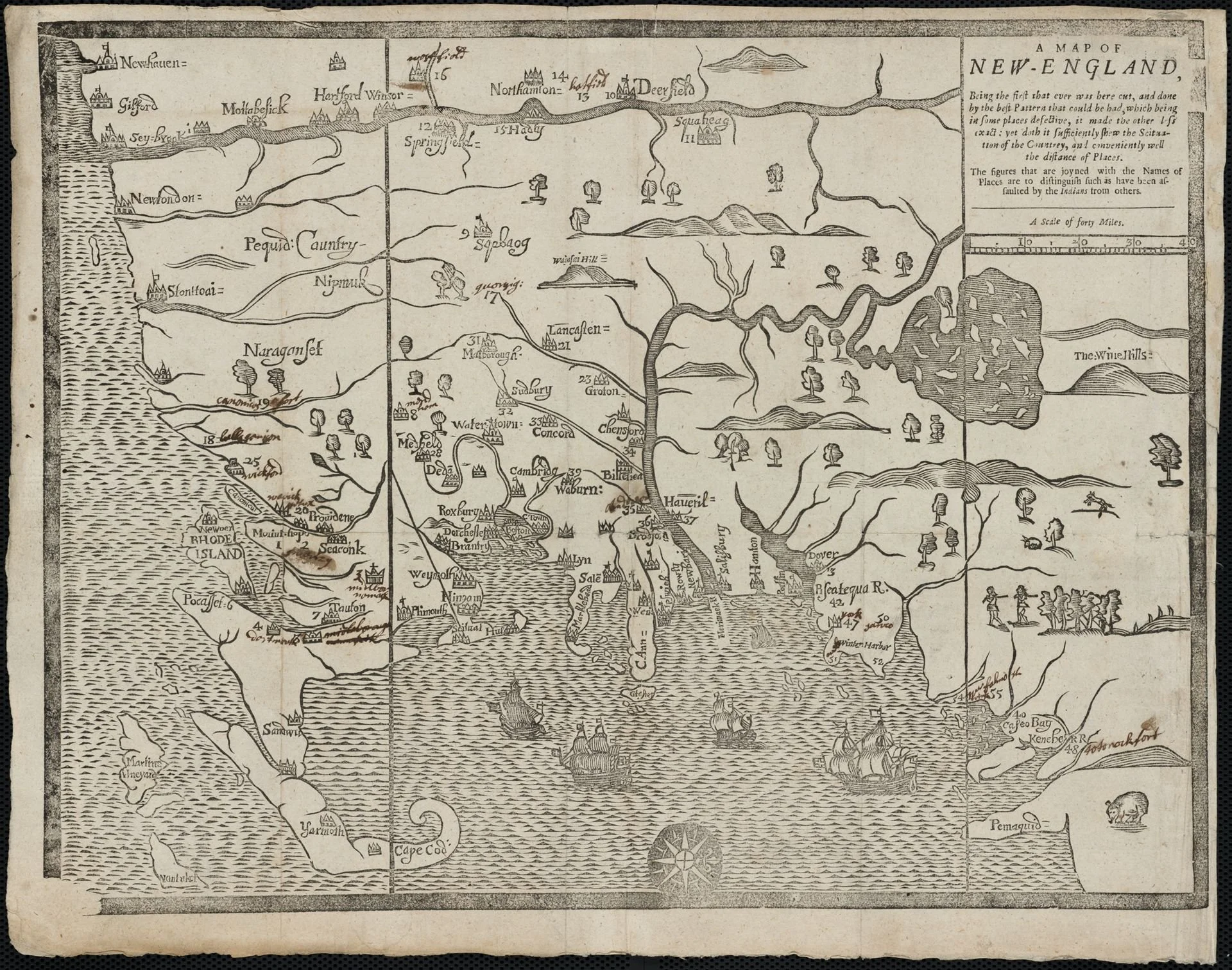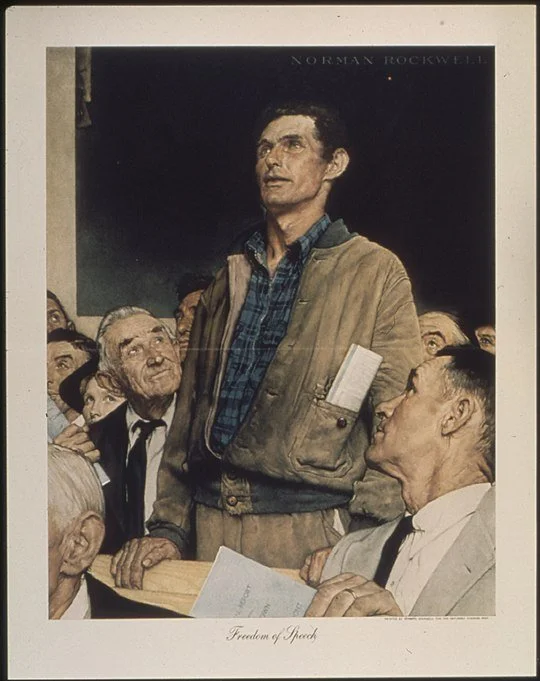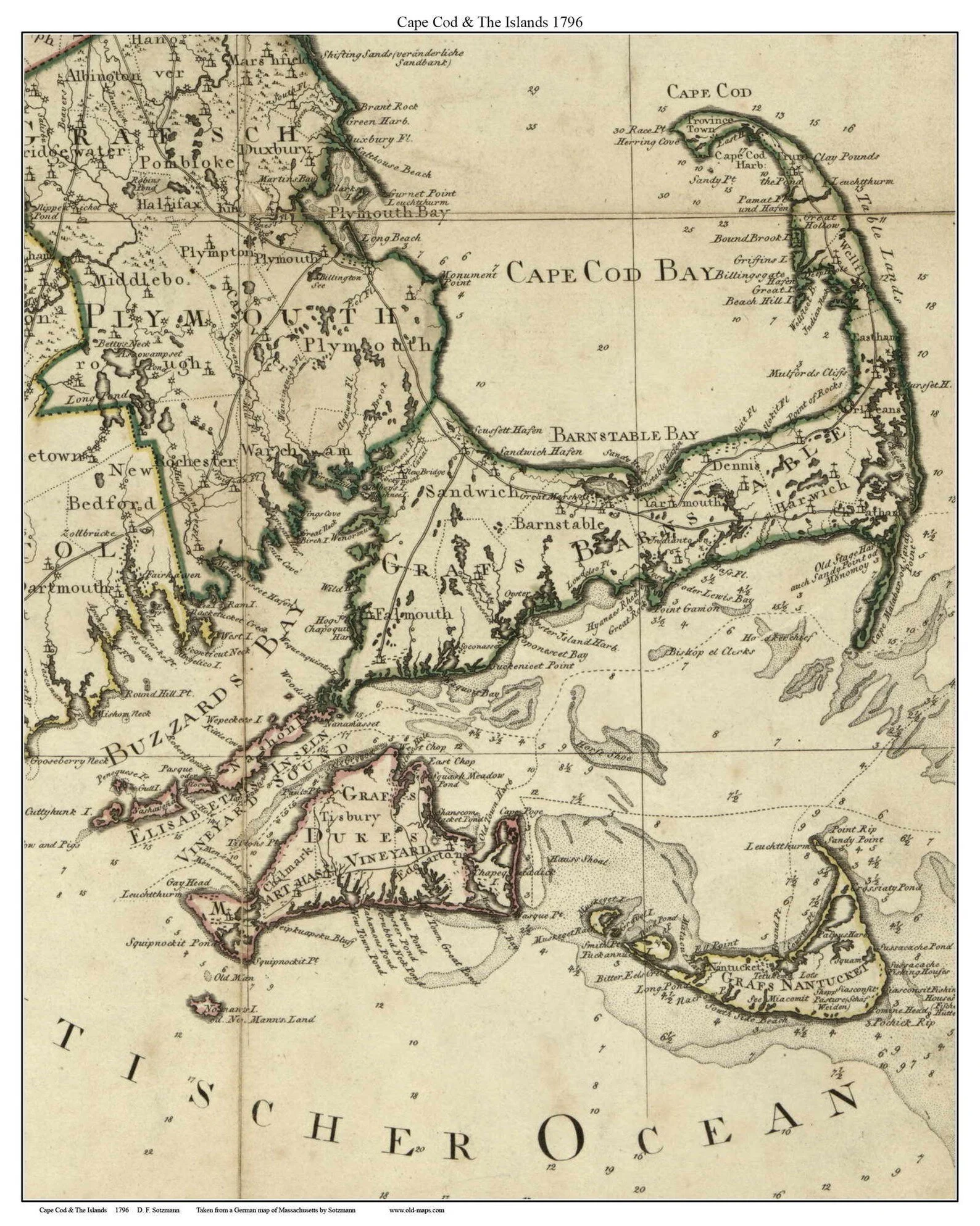‘Personal grievances/vague prejudices’
1943 illustration by Norman Rockwell based on his experience attending town meetings in New England, where he lived, first in Vermont and then in The Berkshires.
“Only people who have witnessed Town Meeting Day in an isolated Berkshire hill town can appreciate its significance….Major political parties don’t come in for much attention…for it’s all a matter of ‘one side’ and the ‘other side’. Personal grievances and vague prejudices are usually the platforms adopted by the ‘sides’’’
— WPA Guide to The Berkshire Hills (1939)
Country Curvature
“Curves — Falmouth (Maine) Nature Preserve’’ (watercolor on paper), by Deena S. Ball, at the Richard Boyd Gallery, on Peaks Island, Portland, Maine, through April 29.
Sara J. Brenneis: Lessons for now in U.S. liberation of Nazi concentration camp
The U.S. Army’s 11th Armored Division entering the Mauthausen concentration camp. The banner in the background (in Spanish) reads as “Anti-fascist Spaniards salute the forces of liberation".
Sara J. Brenneis is Andrew W. Mellon Professor of Spanish at Amherst College
She does not work for, consult, own shares in or receive funding from any company or organization that would benefit from this article, and has disclosed no relevant affiliations beyond their academic appointment.
AMHERST, Mass.
When American soldiers liberated the Mauthausen Nazi concentration camp, in Austria, 80 years ago this May, Spanish prisoners welcomed them with a message of antifascist solidarity.
Both American servicemen and Spanish survivors remember the camp’s liberation as a win in their shared fight against extremism, my research on the Spanish prisoners in Mauthausen finds. They all understood the authoritarian governments of Nazi Germany, Italy and Spain as fascist regimes that used extremist views rooted in intolerance and nationalism to persecute millions of people and imperil democracy across Europe.
World War II, the Holocaust and the horrors of Nazi violence have no modern equivalent. Nevertheless, extremism is now threatening democracy in the United States in recognizable ways.
As the Trump administration executes summary deportations, works to suppress dissent, fundamentally restructures the federal government and defies judges, experts warn that the country is turning toward authoritarianism.
As a scholar of the Mauthausen camp, I believe that understanding how American soldiers and Spanish prisoners experienced its liberation offers a valuable lesson on the real and present dangers of extremism.
‘We knew then why we had to stop Hitler’
In 1938, the Nazis established Mauthausen, a forced- labor camp in Austria, with an international prisoner population. My research shows that the Nazis murdered 16,000 Jews and 66,000 non-Jewish prisoners at Mauthausen between 1938 and 1945, including 60 percent of the roughly 7,200 Spaniards imprisoned there.
The Spanish prisoners were committed antifascist resistors sent there in 1940 and 1941. Known as Republicans or Loyalists, they had fought against Francisco Franco in the Spanish Civil War and Adolf Hitler in World War II.
The young men with the 11th Armored Division of the U.S. Army who liberated Mauthausen would never forget the moment that they discovered the camp. It was May 5, 1945, just days before the war ended in Europe. A platoon led by Staff Sgt. Albert J. Kosiek was repairing bridges in this tucked-away corner of Austria when a Swiss Red Cross delegate alerted them to a large Nazi concentration camp nearby.
Mauthausen’s international survivors were among the Nazis’ last prisoners to be freed.
George Sherman was a 19-year-old tank gunner from Brooklyn when his patrol found Mauthausen. He was Jewish and had read about the Nazi camps in Europe in the Army’s newspaper.
American liberators rolling into the Mauthausen concentration camp on May 5, 1945, as photographed by prisoner Francesc Boix. Sgt. Harry Saunders is standing on the left fender. Francesc Boix/Courtesy of Collections of the Mauthausen Memorial
Still, seeing a concentration camp with his own eyes was alarming.
“The piles of bodies” struck him, he remembered in an oral history recorded for the University of South Florida in 2008. So did “these people walking around like God knows – skeletons and whatnot.”
Sgt. Harry Saunders, a 23-year-old radio operator from Chicago, also remembered the moment he saw the Mauthausen survivors. They were men and women of all nationalities.
“The live skeletons, the people that were in the camp, it was indescribable, it was such a shock,” he said in a 2002 interview for the Mauthausen Memorial’s Oral History Collection in Vienna.
One of the Spanish prisoners at Mauthausen, Francesc Boix, had stolen a camera from the SS in the chaotic moments before the camp’s liberation. Boix photographed Sgt. Saunders rumbling into the concentration camp on an armored car.
Saunders kept that photograph for the rest of his life. It captured a moment of clarity for him.
“When we liberated Mauthausen, we really knew then why we had to stop Hitler and why we really went to war,” he said in the interview.
Frank Hartzell, a technical sergeant with the 11th Armored Division, was 20 when he helped to liberate Mauthausen. He turned 100 this year. We met in mid-March 2025 and discussed his wartime experience.
“What I saw and experienced appalled me,” Hartzell told me.
The outrage has stayed with him for 80 years.
‘Starved and crippled but alive’
The American liberators toured the gas chambers and the crematory ovens in Mauthausen.
Maj. Franklin Lee Clark saw the dead stacked up in “piles like cord wood to the point that they had to bring in bulldozers and make mass graves,” and took photos to document it.
The Spanish banner hanging on the Mauthausen prison gate, May 1945. Franklin Lee Clark/Emory University Archives, Witnesses to the Holocaust Project
Soldiers from the 11th Armored Division directed locals to bury the men and women murdered by the Nazis. The local Austrians claimed they had not known about their town’s concentration camp. But a farmer who lived nearby had been upset about all the dead bodies visible from her property. She filed a complaint asking the Nazis either to stop “these inhuman deeds” or do them “where one does not see it.”
The American liberators made sure that the townspeople could no longer look away from the murderous rampage carried out in their backyards.
While Boix was taking photos of American soldiers during liberation, the soldiers were taking photos of the welcome banner the Spaniards had painted.
On the back of one snapshot, a Signal Corps soldier typed out his impressions of their message: “I really know what that word (antifascist) means. We liberated these prisoners in the Mauthausen concentration camp near Linz, Austria. They were Poles, Hungarians and Spanish Loyalists (remember the Loyalists?). They had men and women in this camp. Starved and crippled but alive.”
After Mauthausen was liberated, the freed Loyalists set to work documenting the Nazis’ crimes. Along with his countrymen Joan de Diego, Casimir Climent and others, Spanish survivor Joaquín López Raimundo compiled lists of Mauthausen victims and their Nazi captors. Using the Nazis’ own typewriters, they spent two weeks listing the names and personal details of Spanish victims of Mauthausen and of the SS who had killed them.
The result was page after page of evidence they handed over to American war crimes investigators and the International Red Cross.
Boix, meanwhile, gave the Americans hundreds of photo negatives he had rescued from the camp’s photography lab.
Boix later testified about these images in the war crime trials at Nuremberg and Dachau. He described seeing the Nazis beat, torture and murder their victims in Mauthausen and then photograph the bodies. For 2½ years, Boix stole the photographic evidence of their crimes.
He “could not keep those negatives because it was so dangerous,” he testified at Dachau, so he “hid them in various places until the liberation.”
lifelong vaccine against extremism
For the American liberators, their up-close view of the horrors of Mauthausen and their interactions with the Spanish antifascist survivors was a lifelong vaccine against extremism.
They witnessed how a fascist leader tore the world apart. They saw with their own eyes the death and destruction of political extremism.
When I interviewed Hartzell, he expressed concern that the United States is going down a dangerous path.
“The USA today is not the USA I fought and came close to dying for,” Hartzell told me.
As American Mauthausen liberator Maj. George E. King warned an interviewer in 1980:
“This is the lesson we have to learn: It could happen here.”
Tarek Alexander Hassan: America’s trade deficit Shows the nation’s economic strength
Container ship Ever Fortune in Boston Harbor, in January 2022
— Photo by Arnold Reinhold
From The Conversation (except for image above).
Tarek Alexander Hassan is a professor of economics at Boston University.
He does not work for, consult, own shares in or receive funding from any company or organization that would benefit from this article, and has disclosed no relevant affiliations beyond their academic appointment.
BOSTON
When President Trump imposed sweeping new tariffs on imported goods on April 2, 2025 – upending global trade and sending markets into a tailspin – he presented the move as a response to a crisis. In an executive order released the same day, the White House said the move was necessary to address “the national emergency posed by the large and persistent trade deficit.”
A trade deficit – when a country imports more than it exports – is often viewed as a problem. And yes, the U.S. trade deficit is both large and persistent. Yet, as an economist who has taught international finance at Boston University, the University of Chicago and Harvard, I maintain that far from a national emergency, this persistent deficit is actually a sign of America’s financial and technological dominance.
trade deficit is flip side of investment magnet
A trade deficit sounds bad, but it is neither good nor bad.
It doesn’t mean that the U.S. is losing money. It simply means that foreigners are sending the U.S. more goods than the U.S. is sending them. America is getting more cheap goods, and in return it is giving foreigners financial assets: dollars issued by the Federal Reserve, bonds from the U.S. government and American corporations, and stocks in newly created firms.
That is, a trade deficit can only arise if foreigners invest more in the U.S. than Americans invest abroad. In other words, a country can only have a trade deficit if it also has an equally sized investment surplus. The U.S. is able to sustain a large trade deficit because so many foreigners are eager to invest here.
Why? One major reason is the safety of the U.S. dollar. Around the world, from large corporations to ordinary households, the dollar is used for saving, trading and settling debts. As the world economy grows, so does foreigners’ demand for dollars and dollar-denominated assets, from cash to Treasury bills and corporate bonds.
Because the dollar is so attractive, the Federal Reserve gets to mint extra cash for use abroad, and the U.S. government and American employers and families can borrow money at lower interest rates. Foreigners eagerly buy these U.S. financial assets, which enables Americans to consume and invest more than they ordinarily could.
In return for our financial assets, we buy more German machines, Scotch whiskey, Chinese smartphones, Mexican steel and so on.
Blaming foreigners for the trade deficit, therefore, is like blaming the bank for charging a low interest rate. We have a trade deficit because foreigners willingly charge us low interest rates – and we choose to spend that credit.
U.S. entrepreneurship Lures global capital – and fuels deficit
Another reason for foreigners’ steady demand for U.S. assets is American technological dominance: When aspiring entrepreneurs from around the world start new companies, they often decide to do so in Silicon Valley. Foreigners want to buy stocks and bonds in these new companies, again adding to the U.S. investment surplus.
This strong demand for U.S. assets also explains why Trump’s last trade war in 2018 did little to close the trade deficit: Tariffs, by themselves, do nothing to reduce foreigners’ demand for U.S. dollars, stocks and bonds. If the investment surplus doesn’t change, the trade deficit cannot change. Instead, the U.S. dollar just appreciates, so that imports get cheaper, undoing the effect of the tariff on the size of the trade deficit. This is basic economics: You can’t have an investment surplus and a trade surplus at the same time, which is why it’s silly to call for both.
It’s worth noting that no other country in the world enjoys a similarly sized investment surplus. If a normal country with a normal currency tries to print more money or issues more debt, its currency depreciates until its investment account – and its trade balance – goes back to something close to zero. America’s financial and technological dominance allows it to escape this dynamic.
That doesn’t mean all tariffs are bad or all trade is automatically good. But it does mean that the U.S. trade deficit, poorly named though it is, does not signify failure. It is, instead, the consequence – and the privilege – of outsized American global influence.
The president’s frenzied attacks on the nation’s trade deficit show he’s misreading a sign of American economic strength as a weakness. If the president really wants to eliminate the trade deficit, his best option is to rein in the federal budget deficit, which would naturally reduce capital inflows by raising domestic savings.
Rather than reviving U.S. manufacturing, Trump’s extreme tariffs and erratic foreign policy are likely to instead scare off foreign investors altogether and undercut the dollar’s global role. That would indeed shrink the trade deficit – but only by eroding the very pillars of the country’s economic dominance, at a steep cost to American firms and families.
He wants to be alone
In Orlando Furioso, Angelica meets a hermit.
— By Gustave Dore (1832-1883), French artist
“The peculiarity of the New England hermit has not been his desire to get near to God but his anxiety to get away from man.’’
— Hamilton Wright Mabie (1845-1916), American essayist and editor
High-fiber art
“Experiment II,’’ by Anna Kristina Goransson, in her show “Topia,’’ at Boston Sculptors Gallery, through May 4.
The gallery says she is “a fiber sculptor working mostly with felted wool to create three-dimensional sculptures and installations. The process of taking fluffy wool fibers and creating a strong material that is light-weight and accepts dyes so well has intrigued her since she found this technique in 2004 during her MFA studies at UMass Dartmouth. Having always been a three-dimensional thinker, starting her career as a furniture maker educated at RISD, Kristina is drawn towards working things out sculpturally.’’
Border crossings
“Signage” (Mixed-media painting), by Tom Arsenault, in his show “Travels,’’ at the Corner Gallery, Jaffrey, N.H., through May 21.
The gallery says:
“Deftly merging paint and historical artifact, Arsenault creates ethereal scenes that evoke curiosity and emotion. Blending objects of art from both Eastern and Western traditions, his work seemingly transcends time and place, instead drawing the viewer into a mysterious dreamscape of rich color and surprising depth.’’
Mt. Monadnock, in Jaffrey, one of the world’s most climbed mountains, and the subject of much literature, as painted by Richard Whitney in “Monadnock Orchard’’.
Image from Richard Whitney
A dwelling for us
Adapted from Robert Whitcomb’s “Digital Diary,’’ in GoLocal24.com
Architectural historian and critic William Morgan’s book The Cape Cod Cottage tells the story of an architectural style that started in southeastern Massachusetts as 17th Century colonists’ adapted English houses to our hardy climate. The low-to-the-ground and one-to-one-and-a-half-story dwellings, with center fireplaces and steep roofs with gables, were modest buildings that evoked the practical and aesthetic attributes of the Puritans/Pilgrims.
Mr. Morgan’s history-rich essay and the terrific collection of photos, most by him, that follow make this little book a joy.
Sided with cedar shingles, which in the region’s damp, windy and salty wind turn gray, or with simple clapboard, Cape Cod Cottages from the start evoked a calm domesticity.
Many old Capes have been, to say the least, heavily modified since those early days, with, for example, porches, wings and floors added on, not to mention garages with big ugly doors. Some new alleged “Capes” you might hardly recognize as in that style – too big and pretentious -- McMansions. But the simplicity of those that adhere to the original need or desire for simplicity and economy have continued to lure buyers. Note how many of the post-World War II housing developments, such as the Levittowns, featured small Capes and “modest Capes’’ are still being put up around the country, even in such places as deserts Out West.
I have generally happy memories of my Cape Cod relatives’ cedar-shingled Capes. The newer ones (built since the 19th Century) have two full second floors, but the basic house design was the same. If there was a water view available, lots of owners would stick a porch on that side, often glassing it in.
I well recall the oddly pleasant musty smell (maybe allergy-inciting for some people) of these cozy houses, up from the immediate shoreline in cedar and oak woods , and connect it with my laconic and ironic grandparents and other relatives down there, descendants of Puritans, Pilgrims and Quakers. They never seemed to swear and used phrases such as “don’t-cha-know?” (instead of “you know?’’) and “don’t give me any guff’’ that I haven’t heard for a very long time.
(This book was originally published in 2006 by Princeton Architectural Press in paperback. It’s now being reissued in hardcover by Abbeville and with a new cover design.)
“Spider at His Trade again’
Stephencdickson photo
Anita Martinz photo
An altered look about the hills—
An altered look about the hills—
A Tyrian light the village fills—
A wider sunrise in the morn—
A deeper twilight on the lawn—
A print of a vermillion foot—
A purple finger on the slope—
A flippant fly upon the pane—
A spider at his trade again—
An added strut in Chanticleer—
A flower expected everywhere—
An axe shrill singing in the woods—
Fern odors on untravelled roads—
All this and more I cannot tell—
A furtive look you know as well—
And Nicodemus' Mystery
Receives its annual reply!
—Emily Dickinson (1830-1886), the famed poet who lived in Amherst, Mass.
Llewellyn King: God save us from our cowardly Congress
The former Londonderry Arms, now called the Harbourview Hotel.
WEST WARWICK, R.I.
October 1989 found me in a small hotel, the Londonderry Arms, on the Antrim Coast of Northern Ireland. It was during “The Troubles” and evidence of the sectarian strife was everywhere, even along that beautiful shoreline, complete as it is with the Giant’s Causeway, one of Northern Ireland’s big tourist attractions.
My wife, Linda Gasparello, and I were reminded of the bitter divisions between Protestants and Catholics when we were stopped by British soldiers at a roadblock. They were polite and checked our papers. While they were doing that, Linda said, “Aren’t those soldiers vulnerable, standing like that in the open road?”
“Take a look over there,” I replied.
Just as I knew there would be, there was a soldier in a ditch with a machine gun trained on us and offering cover to the troops.
It was a reminder of just how bad things were in Northern Ireland at the time with frequent murders, kneecapping, and a lack of any communication between Protestants and Catholics. One people divided by their religious and historical burden.
The Londonderry Arms was a hotel of historic importance, having once been owned briefly by Winston Churchill and which was operated from 1948 until last year by the legendary O’Neill family.
We had been warmly welcomed and made at home by Frankie O’Neill. After dinner at the hotel, he came to me and said, “I am afraid I won’t be able to be with you after today because I am taking my sister to Washington to see the Congress at work.”
“Why?” I asked.
One could imagine traveling to Washington to see the museums, the White House and the Capitol. But Congress in session, that querulous place with its confusing systems and norms?
Then he explained that the Northern Ireland Parliament, called Stormont, after Stormont Castle where it meets, is based on the British House of Commons where party discipline is rigid. Under a parliamentary system, the government of the day would fall if there were no party discipline. If you are Labor, you vote Labor; if Conservative, you vote Conservative. Only very occasionally is there a free vote on a moral issue, like the death penalty.
That meant, O’Neill told me, that in Northern Ireland, Catholics and Protestants were on opposite sides of the aisle and the government was always at a standstill.
He thought that the American legislative system, with its ability to incorporate minority views, and for minorities to introduce and pass legislation of interest only to a fragment of the population, was a beacon for Ireland.
I don’t think that O’Neill would take his sister to Washington today to see the Congress as it is now: inglorious, pusillanimous, fawning men and women more concerned with their own job protection than discharging the high duty of the House and the Senate. Worse, its magnificent independence has been traded for obsequious party loyalty.
Of course, the lickspittle members of Congress at present are the wretched, obsequious, groveling Republicans who have enabled President Trump to trample the Constitution and usurp the powers of Congress.
But one has to say the Democrats are hardly admirable, not exactly an impressive body of leaders. In their way, they are humbled by their own diminished concept of the role of the loyal opposition.
The Republicans may be the more guilty invertebrates, but the equivalence of the Democrats is also noteworthy in this sad abrogation of responsibility that has taken hold of the political class in Congress. Look no further than Senate Minority Leader Chuck Schumer’s failure of courage in throwing in with the Republicans to keep the government open. It was political will withering in plain sight.
As someone who was covering Congress at the time of O’Neill’s declaration about the superiority of Congress as a democratic legislating arrangement, I have seen that great body subsume the national interest to personal job security and fear of criticism from on high, the White House.
The great thing at that time was the individualism of members of Congress, who had a keen eye to their constituents and what they felt was the national interest.
Sadly, that grand time of free-for-all legislating came to an end when Newt Gingrich took up the House speaker’s gavel in 1994 and introduced a concept of party discipline more appropriate to Westminster than to Capitol Hill. Shame.
On Twitter: @llewellynking2
Llewellyn King is executive producer and host of White House Chronicle, on PBS, and an international energy-sector consultant and speaker. He’s based in Rhode Island.
Boston’s housing-creation Drought worsens
Excerpted and edited from a Boston Guardian article.
After booming during Mayor Marty Walsh’s years, construction of new apartments, condos and homes in Boston has plunged.
The drop-off began in mid-2022 as the Federal Reserve hiked interest rates to battle inflation and as Boston Mayor Michelle Wu shifted city housing policy away from her predecessor’s pro-growth approach.
During her first months in office, Wu unveiled an ultimately unsuccessful plan to bring back a form of rent control, while also vowing to hike affordable housing and energy efficiency for new housing developments.
And while Marty Walsh had focused on boosting the volume of new housing produced by encouraging private-sector development, Wu refocused city efforts on building more public housing.
Now the decline appears to be gaining speed, with the city’s Building Department issuing just building permits for just 72 new housing units in March, according to a review of city records….
This caps a dismal, seven-month run in which housing starts in Boston have fallen to their lowest levels since at least 2018.














